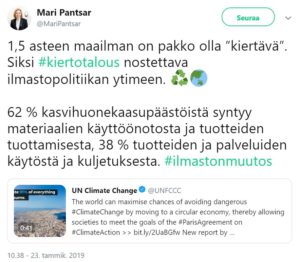The claim is backed by an actual study, but experts suggest the exact percentages are difficult to determine.
On 23 January 2019, Mari Pantsar, the Director of carbon-neutral circular economy of Sitra, a Finnish Innovation Fund, claimed on Twitter:
“A 1.5 degree world can only be “circular.” That’s why the #circulareconomy has to be placed at the core of climate policy.
A total of 62% of the global greenhouse gas emissions are released during the extraction, processing and manufacturing of goods, 38% are emitted in the delivery and use of products and services. #climatechange”

Climate change has provoked a lot of public discussion in Finland after the Intergovernmental Panel on Climate Change (IPCC) released its large report last year. The country is currently heading towards both general and European elections, and the politicians’ position on climate change is expected to be one of the main issues affecting people’s voting behaviour. Pantsar’s tweet brings the less-often mentioned role of circularity into this discussion.
The circular economy, which Pantsar is talking about in her tweet, is an economic system that aims to minimise waste. In a circular system products are reused and recycled rather than thrown away and the manufacturing and consumption of products produces as little emissions and waste as possible.
Sitra is an innovation fund controlled by the Finnish Parliament. One of its goals is to build a sustainable Finland for the future by focusing on carbon neutral circular economy.
In her tweet Pantsar refers to The Circularity Gap report by Circle Economy and the press release linked to it. The claim is based on an authoritative, quantitative study by Circle Economy.
Circle Economy is a social enterprise based in Amsterdam, Netherlands. The enterprise receives funding from several, mainly Dutch foundations and organizations including the Nationale Postcode Loterij (the biggest charity lottery in the Netherlands), Adessium Foundation (a privately funded public-benefit organisation), and De Hoge (a private equity firm). Its stated mission is “to accelerate the practical and scalable implementation of the circular economy”.
The research was based on life cycle analysis: for example, the amount of energy used extracting the materials from the country, emissions caused by the operation itself, and by the manufacturing process of the product.
Our consumption causes a lot of emissions
“In 2017, the total greenhouse gas emissions (excluding land use and forestry) were 50.9 bln tonnes of CO2 equivalent including: 12.5 bln from extraction; 10 bln from processing; 9.3 bln from production; 6.5bln from delivery of products and services; and 12.7 bln caused by consumption“, says The Circularity Gap report.
Circle Economy bases its analysis mostly on the report by PBL Netherlands Environmental Assessment Agency, an autonomous research institute which is also part of the Dutch Ministry of Infrastructure. Along with researching and publishing reports related to ecology, environment and economy, the institute advises the Dutch government on these matters.
According to the agency, there is some uncertainty when it comes to the global greenhouse gas emission estimates. The uncertainty is estimated at 10%. The agency also states that effects of forestry and land use have been excluded from the calculations.
The Finnish Climate Change Panel is an independent think tank. The work of the panel is based on the Finnish Climate Change Act and it aims to bring science and decision-making together. Its chairperson, professor Markku Ollikainen, says that greenhouse gas emissions cannot be calculated this precisely.
“These numbers come with uncertainties. They are for sure just rough estimates.’’
In short, greenhouse gas emissions cannot probably be calculated with this degree of accuracy. Pantsar’s tweet itself does not include the fact that effects of forestry and land use has been excluded from the calculations of The Circularity Gap report.
Leave your comments, thoughts and suggestions in the box below. Take note: your response is moderated.
RESEARCH | ARTICLE © Vilma Leppikangas, Anastasia Ranta, Juha Rapo, Olli Söderkultalahti, Haaga-Helia University of Applied Sciences, FI





